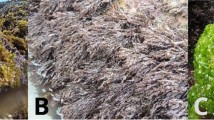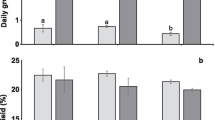Abstract
Eucheumatopsis isiformis Núñez-Resendiz, Dreckmann & Sentíes is a red alga with great economic potential due to its iota-carrageenan content that could serve as a substitute for traditional carrageenan sources (Freile-Pelegrín and Robledo, J Appl Phycol 20:537–541, 2008) such as the red alga Kappaphycus alvarezii (Loureiro et al., New Phytol 206:489–492, 2015), if it can be reliably and sustainably cultivated in open water. Due to prevailing and changing climatic conditions, it is necessary to retain germplasm and to cultivate this alga in tank systems. To develop the necessary, large volumes of seed stock required for stocking open water cultivation farms, three brown seaweed-derived biostimulants were tested. One of these was manufactured from the kelp Ecklonia maxima, the other two were manufactured from the intertidal fucoid Ascophyllum nodosum. Apical segments of E. isiformis were treated either by dipping or by continuous exposure to the biostimulants, at different concentrations. Growth was assessed every seven days by measuring the maximum length of each segment, number of lateral shoots produced by each shoot, fresh weight, and the maximum diameter. The constant exposure treatment produced a greater number of shoots per propagule with no significant effects driven by any of the biostimulants. Increasing or decreasing the concentration of the biostimulants to improve the performance of the dipping protocol was not effective, as compared with a constant exposure protocol. This study supports the increasing number of research articles related to the positive benefits of using macroalgal-derived extracts as biostimulants to support seaweed cultivation.


Similar content being viewed by others
References
Abe H, Uchiyama M, Sato R (1972) Isolation and identification of native auxins in marine algae. Agric Biol Chem 36:2259–2260
Al-Hawezy SMN (2014) The use of Kelpak to seedlings loquat (Eriobotya japonica L.). Int J Sci Res Publ 4:85–88
Ali MM, Sani MZB, Hi KK, Yasir SM, Critchley AT, Hurtado AQ (2018) The comparative efficiency of a brown algal-derived biostimulant extract (AMPEP), with and without supplemented PGRs: the induction of direct, axis shoots as applied to the propagation of vegetative seedlings for the successful mass cultivation of three commercial strains of Kappaphycus in Sabah, Malaysia. J Appl Phycol 30:1913–1919
Aremu AO, Plačková L, Gruz J, Bíba O, Novák O, Stirk WA, Doležal K, Van Staden J (2016) Seaweed-derived biostimulant (Kelpak®) influences endogenous cytokinins and bioactive compounds in hydroponically grown Eucomis autumnalis. J Plant Growth Regul 35:151–162
Battacharyya D, Babgohari MZ, Rathor P, Prithiviraj B (2015) Seaweed extracts as biostimulants in horticulture. Sci Hortic (Amsterdam) 196:39–48
Cheney DP (1988) The genus Eucheuma J. Agardh in Florida and the Caribbean. In: Abbott IA (ed) Taxonomy of economic seaweeds with reference to some Pacific and Caribbean species. University of California, La Jolla, pp 209–219
Craigie JS (2011) Seaweed extract stimuli in plant science and agriculture. J Appl Phycol 23:371–393
Crouch IJ, van Staden J (1991) Evidence for rooting factors in a seaweed concentrate prepared from Ecklonia maxima. J Plant Physiol 137:319–322
Crouch IJ, van Staden J (1993) Evidence for the presence of plant growth regulators in commercial seaweed products. Plant Growth Regul 13:21–29
Crouch IJ, Beckett RP, van Staden J (1990) Effect of seaweed concentrate on the growth and mineral nutrition of nutrient-stressed lettuce. J Appl Phycol 2:269–272
Dawes CJ, Mathieson AC, Cheney DP (1974) Ecological studies of Floridian Eucheuma (Rhodophyta, Gigartinales). I. Seasonal growth and reproduction. Bull Mar Sci 24:236–272
De Saeger J, Van Praet S, Vereecke D, Park J, Jacques S, Han T, Depuydt S (2020) Toward the molecular understanding of the action mechanism of Ascophyllum nodosum extracts on plants. J Appl Phycol 32:573–597
Fredericq S, Freshwater DW, Hommersand MH (1999) Observations on the phylogenetic systematics and biogeography of the Solieriaceae (Gigartinales, Rhodophyta) inferred from rbcL sequences and morphological evidence. Hydrobiologia 398–399:25–38
Freile-Pelegrín Y, Robledo D (2008) Carrageenan of Eucheuma isiforme (Solieriaceae, Rhodophyta) from Nicaragua. J Appl Phycol 20:537–541
Freile-Pelegrín Y, Robledo D, Azamar JA (2006) Carrageenan of Eucheuma isiformis (Solieriaceae, Rhodophyta) from Yucatán, Mexico. I. Effect of extraction conditions. Bot Mar 49:65–71
Guiry MD, Guiry GM (2019) AlgaeBase. World-wide electronic publication. National University of Ireland, Galway http://www.algaebase.org. Accessed 6 Nov 2019
Hurtado AQ, Critchley AT (2018) A review of multiple biostimulant and bioeffector benefits of AMPEP, an extract of the brown alga Ascophyllum nodosum, as applied to the enhanced cultivation and micropropagation of the commercially important red algal carrageenophyte Kappaphycus alvarezii. J Appl Phycol 30:2859–2873
Hurtado AQ, Joe M, Sanares RC, Fan D, Prithiviraj B, Critchley AT (2012) Investigation of the application of Acadian Marine Plant Extract Powder (AMPEP) to enhance the growth, phenolic content, free radical scavenging, and iron chelating activities of Kappaphycus Doty (Solieriaceae, Gigartinales, Rhodophyta). J Appl Phycol 24:601–611
Hurtado-Ponce AQ (1992) Cage culture of Kappaphycus alvarezii var.tambalang (Gigartinales, Rhodophyceae). J Appl Phycol 4:311–313
Khan W, Rayirath UP, Subramanian S, Jithesh MN, Rayorath P, Hodges DM, Critchley AT, Craigie JS, Norrie J, Prithiviraj B (2009) Seaweed extracts as biostimulants of plant growth and development. J Plant Growth Regul 28:386–399
Khan W, Hiltz D, Critchley AT, Prithiviraj B (2011) Bioassay to detect Ascophyllum nodosum extract-induced cytokinin-like activity in Arabidopsis thaliana. J Appl Phycol 23:409–414
Kim JK, Yarish C (2014) Development of a sustainable land-based Gracilaria cultivation system. Algae 29:217–225
Kim JK, Yarish C, Hwang EK, Park MS, Kim YD (2017) Seaweed aquaculture: cultivation technologies, challenges and its ecosystem services. Algae 32:1–13
Kim JK, Stekoll M, Yarish C (2019) Opportunities, challenges and future directions of open water seaweed aquaculture in the United States. Phycologia 58:446–461
Kocira A, Świeca M, Kocira S, Złotek U, Jakubczyk A (2018) Enhancement of yield, nutritional and nutraceutical properties of two common bean cultivars following the application of seaweed extract (Ecklonia maxima). Saudi J Biol Sci 25:563–571
Lewin J (1966) Silicon metabolism in diatoms. V. Germanium dioxide, a specific inhibitor of diatom growth. Phycologia 6:1–12
Loureiro RR, Reis RP, Berrogain FD, Critchley AT (2014a) Effects of a commercial extract of the brown alga Ascophyllum nodosum on the biomass production of Kappaphycus alvarezii (Doty) Doty ex P. C Silva and its carrageenan yield and gel quality cultivated in Brazil. J Appl Phycol 26:763–768
Loureiro RR, Reis RP, Marroig RG (2014b) Effect of the commercial extract of the brown alga Ascophyllum nodosum Mont. on Kappaphycus alvarezii (Doty) Doty ex P.C. Silva in situ submitted to lethal temperatures. J Appl Phycol 26:629–634
Loureiro R, Gachon CMM, Rebours C (2015) Seaweed cultivation: potential and challenges of crop domestication at an unprecedented pace. New Phytol 206:489–492
MARINER (2017) Macroalgae research inspiring novel energy resources. https://arpa-e.energy.gov/?q=arpa-e-programs/mariner. Accessed 6 Nov 2019
Moon RE, Dawes CJ (1976) Pigment changes and photosynthetic rates under selected wavelengths in the growing tips of Eucheuma isiforme (C. Agardh) J. Agardh var deudatum Cheney during vegetative growth. Br Phycol J 11:165–174
Núñez-Resendiz ML, Dreckmann KM, Sentíes A, Wynne MJ, León-Tejera HP (2019) Eucheumatopsis isiformis gen. & comb. nov. (Solieriaceae, Rhodophyta) from the Yucatán peninsula, to accommodate Eucheuma isiforme. Phycologia 58:51–62
Panda D, Pramanik K, Nayak BR (2012) Use of sea weed extracts as plant growth regulators for sustainable agriculture. Int J Bio-res Stress Manag 3:404–411
Redmond S, Green L, Yarish C et al (2014) New England seaweed culture handbook. University of Connecticut Sea Grant, Connecticut
Robertson-Andersson DV, Leitao D, Bolton JJ, Anderson RJ, Njobeni A, Ruck K (2006) Can kelp extract (Kelpak®) be useful in seaweed mariculture? J Appl Phycol 18:315–321
Schaffelke B (1995) Abscisic acid in sporophytes of three Laminaria species (Phaeophyta). J Plant Physiol 146:453–458
Souza JMC, Castro JZ, Critchley AT, Yokoya NS (2018) Physiological responses of the red algae Gracilaria caudata (Gracilariales) and Laurencia catarinensis (Ceramiales) following treatment with a commercial extract of the brown alga Ascophyllum nodosum (AMPEP). J Appl Phycol 31:1883–1888
Stirk WA, Van Staden J (2006) World seaweed resources. South Afr J Bot 72:666
Stirk WA, Novák O, Hradecká V, Pénčík A, Rolčík J, Strnad M, van Staden J (2009) Endogenous cytokinins, auxins and abscisic acid in Ulva fasciata (Chlorophyta) and Dictyota humifusa (Phaeophyta): towards understanding their biosynthesis and homoeostasis. Eur J Phycol 44:231–240
Stirk WA, Tarkowská D, Turečová V, Strnad M, van Staden J (2014) Abscisic acid, gibberellins and brassinosteroids in Kelpak®, a commercial seaweed extract made from Ecklonia maxima. J Appl Phycol 26:561–567
Szczepanek M, Siwik-Ziomek A (2019) P and K accumulation by rapeseed as affected by biostimulant under different NPK and S fertilization doses. Agronomy 9:9090477
Tibubos KR, Hurtado AQ, Critchley AT (2017) Direct formation of axes in new plantlets of Kappaphycus alvarezii (Doty) Doty, as influenced by the use of AMPEP K+, spindle inhibitors, and plant growth hormones. J Appl Phycol 29:2345–2349
Umanzor S, Shin S, Marty-Rivera M, Augyte S, Yarish C, Kim JK (2019) Preliminary assessment on the effects of the commercial seaweed extract, AMPEP, on growth and thermal tolerance of the kelp Saccharina spp. from the Northwest Atlantic. J Appl Phycol 31:3823–3829
van Staden J, Beckett RP, Rijkenberg MJ (1995) Effects of seaweed concentrate on the growth of the seedligs of three species of Eucalyptus. S Afr J Bot 61:169–172
Wally OSD, Critchley AT, Hiltz D, Craigie JS, Han X, Zaharia LI, Abrams SR, Prithiviraj B (2013) Regulation of phytohormone biosynthesis and cccumulation in Arabidopsis following treatment with commercial extract from the marine macroalga Ascophyllum nodosum. J Plant Growth Regul 32:324–339
Wynne M (2011) A checklist of benthic marine algae of the tropical and subtropical Western Atlantic: fourth revision. J. Cramer i, Stuttgart
Yunque DAT, Tibubos KR, Hurtado AQ, Critchley AT (2011) Optimization of culture conditions for tissue culture production of young plantlets of carrageenophyte Kappaphycus. J Appl Phycol 23:433–438
Zhang L, Cui C, Li X, Zhang Z, Luo S, Liang G, Liu Y, Yang G (2013) Effect of temperature on the development of Saccharina japonica gametophytes. J Appl Phycol 25:261–267
Acknowledgments
The Kelpak® (South Africa) product was provided by John McIntyre, PhD from CalTec Ag. The Acadian® product was a kind gift of the Acadian Seaplants (Canada) and Ocean Organics (US) provided their product as a gift for evaluation. We also acknowledge L. Roberson for providing the macroalgal experimental samples.
Funding
This study was supported by Macroalgae Research Inspiring Novel Energy Resources (MARINER, DE-FOA-0001726) to CY as a sub-award. This work was also supported by the Basic Science Research Program through the National Research Foundation of Korea (NRF) funded by the Ministry of Education (NRF-2017R1A6A1A06015181) and by the Ministry of Oceans and Fisheries of Korea (Project title: Improvement of management strategies on marine ecosystem disturbing and harmful organisms, No. 20190518) to JKK.
Author information
Authors and Affiliations
Corresponding authors
Additional information
Publisher’s note
Springer Nature remains neutral with regard to jurisdictional claims in published maps and institutional affiliations.
Electronic supplementary material
ESM 1
(DOCX 14 kb)
Rights and permissions
About this article
Cite this article
Umanzor, S., Jang, S., Antosca, R. et al. Optimizing the application of selected biostimulants to enhance the growth of Eucheumatopsis isiformis, a carrageenophyte with commercial value, as grown in land-based nursery systems. J Appl Phycol 32, 1917–1922 (2020). https://doi.org/10.1007/s10811-020-02091-7
Received:
Revised:
Accepted:
Published:
Issue Date:
DOI: https://doi.org/10.1007/s10811-020-02091-7




